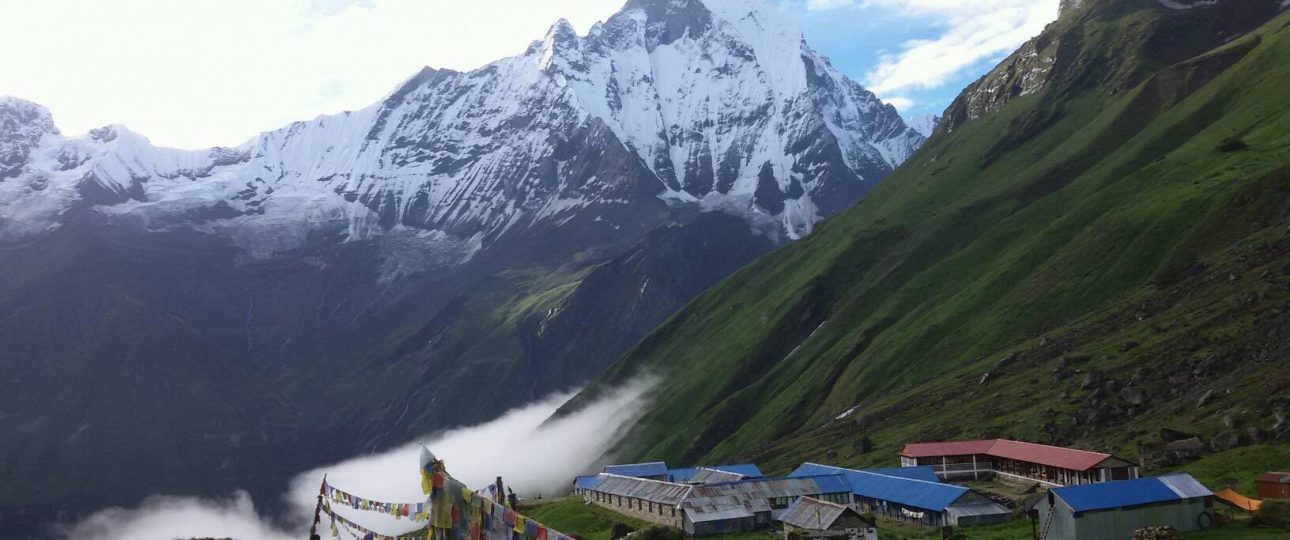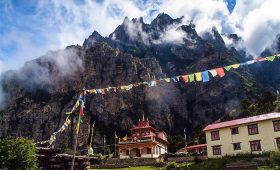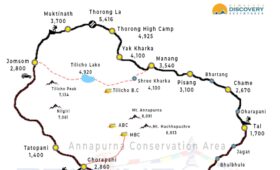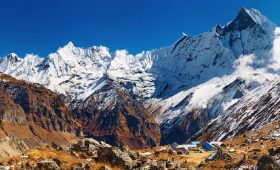Trek to Annapurna Base Camp combines panoramic mountains, traditional mountain life, and biodiversity. While many people are asking about the how difficult is it trek to Annapurna Base Camp? The trek is a moderate one that welcomes both the novice and the experienced trekkers.
Annapurna Base Camp Trek is a relatively easy trek that even in off seasons can be done. The ecosystem of the bamboo trees and the rhododendron forest contributes to the trek’s beauty. This route will introduce you to the inhabitants to Gurung and Magar people. They will surely fill your heart with warm hospitality.
After tough hike, the best views come, this trek takes you to encounter the best panoramic view of the beautiful Annapurna Range and many other mountains over 7000 meter high.
The Himalayan Mountain scenery including the Annapurna, Dhaulagiri, Gangapurna Machhapuchhre, Tilicho Peak, Tent Peak and many other mountains that are more than 7000 meter.
Unlike other treks, no advanced physical fitness level is required at the Annapurna Base Camp Trek. So, anyone with normal health conditions can do this trek. In terms of altitude, this trek is absolutely incredible and comparatively easy.
Annapurna Base Camp Trek Difficulty & Route
Definitely the trail isn’t straight and smooth. There are many ups and downs, and this is a difficult job. You have to concentrate. Even though this trek has no specific health and fitness requirements, a much higher level of stamina and endurance is required for the monotonous and steady up and down movement.
So, if you work on your stamina before this trek or any other trek, it would be of great support.
It takes a lot of energy. Because there are many ups and downs on the route. It’s a little harder than traveling on a hurdle-free path. Therefore, it will be helpful to carry energy boosters along with some snacks like chocolates etc.
And yes, it’s a must to stay hydrated.
Planning your diet, supplements, and snacks you choose to take along would be wise.
One of the best ways to deal with the issue of stamina is to schedule and complete treks at a steady pace. One day at a time, without putting yourself under pressure. You don’t have to get stressed this way and enjoy the moment.
You will be facilitated throughout the trial with a network of hotels and guest houses. You can enjoy the service here, the hospitality, and also rejuvenate and recover all the lost energy.
Also, you can always choose a local lodging in every few hours if you think you need to rest for the day. You can rest or even spend the night if you are too tired.
3300 steep stone steps
One of the most challenging tasks for trekkers is a 3300 step steep stone stairway. It’s a steep and long route. But you can definitely take breaks and walk according to your comfort and ease.
Such challenging experiences will also increase your confident.
Exhaustion is a common problem commonly faced by most people on a long trek. You are the only one who is aware of your physical strength and stamina, so always keep in mind your limitations.
It doesn’t matter how difficult it was during your walk and how stressfully you were able to finish the trek. The only things that matter are the enriching experience you are gaining.
It will be very useful to build up your stamina and prepare for the trip.
Altitude Sickness
While traveling through such a high altitude, it is common that trekkers might face symptoms like;
- Headache that generally gets worse at night and when you wake up
- Loss of appetite
- Feeling sick in your bodies. You may vomit
- Feel weak and tired
- Wake up at night and not sleep well
- Feel dizziness
Things to Remember
- Recent evidence suggests that symptoms of mild altitude sickness are experienced at altitudes up to 3,000 meters above sea level by up to 20% of trekkers. And Annapurna Base Camp Trek is more than 4000m. above average altitude.
- Altitude sickness occurs at higher altitudes because of the lower and thinner availability of air. It’s a very common and normal issue. However, lack of precautions can cause serious health problems. It will take a long way to learn about altitude sickness and its remedies.
- For example, Acute Mountain Sickness can turn from extreme altitudes above 4,500 meters into high altitude pulmonary edema (HAPE) or high-altitude cerebral edema (HACE), both of which are very serious.
- This problem can ruin your trekking program completely as the symptoms of acute mountain sickness usually go away at a lower altitude after two or three days of rest. You will have to return from where you ascended for this.
- Severe syndromes such as HAPE may take weeks to disappear and may even require special medical care and hospitalization.
- There are, however, some tips that can help travelers reduce this problem’s risk.
- The best way would be to climb slowly, sleep low, take regular and necessary medicines, drink more, delay exercises while trekking.
Annapurna Base Camp Trek Difficulty & Seasons
Weather is also the most important factor that should be considered when planning a long trek / travel. Annapurna Base Camp Trek also has some of the best seasons and some are not recommended at all.
Annapurna Base Camp Trek in Autumn
This is the most famous hiking season, along the trail everything is refreshed, stable and vibrant during this period. Being the best season, as a negative part of this, it is also the busiest period of trekking in Nepal.
Thousands of people are seeking the best visibility of the mountains during the fall. So, in the famous regions of Everest and Annapurna they hit the trails. The hotel price peaks during the period due to the high inflow of visitors.
During this season you can take beautiful pictures of the mountains! As the temperature is still cooler, autumn is also a good time to visit Terai. This is also a country festive season with some of Nepal’s popular festivals like Dashain, Tihar and Chhath falling in this period.
Annapurna Base Camp Trek in Spring
After autumn, this is the second most popular season for trekking Most of the snow has disappeared leaving crystal clear skies. Often during May there is a magnificent haze that can be seen from the lower altitudes.
The true miracle and therefore one of Nepal’s best travel times is the spring blossom of rhododendron! Dozens of different species of rhododendron spread in the Himalayan Mountains forests to an altitude of 4000m. and transform them into a beautiful blaze of color with their petals in spring-from bright white to purple red and red!
This creates a spectacular contrast with the Himalayan giants shining in the sun. We highly recommend Annapurna Base Camp Trek during this time of the year.
Annapurna Base Camp Trek in Summer
There’s a lot to know about Nepal’s other travel times! In summer, Nepal and the Himalayas are under tight control of the monsoon-the rainy season. Trekking is not suggested in most areas. There are exceptions: the influenced Tibetan highlands Upper Mustang Trek, Upper Dolpo Trek or Nar Phu Valley Trek are in the Himalayan rain-shadow and therefore suitable for trekking experiences.
You need to be prepared for arrival delays (domestic flights are often cancelled). And the not too high Himalayan regions, as well as the foothills and Pre-Himalayas, are attractive in winter.
Please remember the short time of daylight when planning the daily stages and the crossing of frozen water streams can turn out to be a delicate task-often also for the crew. The Annapurna Base Camp is also good to trek during summer!
Annapurna Base Camp Trek in Winter
Maybe this is not the season you’d like to hike. This is the route’s coldest period. Daytime temperatures will be cold depending on the altitude and the temperature will drop below the freezing point at night.
The trade-off is that there is a lot less crowded trails than other seasons. During this time, tea houses stay open. Clouds more frequently prevail, but there are still clear days. Unfortunately, avalanches are also most common in this period.
Well, the worst part is when you’re unprepared to face a difficult situation. But everything is possible with a bit of pre-information and preparation. The way you can tackle a problem will give you a lot of experience and preparation. Knowing ways to deal with a certain unpredictable situation will make you much wiser.
Few Tips for Annapurna Base Camp Trek
Here are a few tips that might be helpful during Annapurna Base Camp Trek.
- If you order Nepali or Dal Bhat tarkari meal set, you may take seconds and thirds free of charge, except for meat. Eat whatever you like.
- Carry enough cash with you during the ABC trail does not have ATMs.
- Set aside around $150 to pay for monastery and museum transportation and entry fees.
- Add some days of contingency as one more day may be needed to acclimatize. Or you might want to discover another location.
- Don’t trust all the locals. There may be bad people anywhere. Let’s say, if you ask how far Place A is, they might say you’ve got to Place A to get you to stay in their tea house. Not everybody is like that. Most are useful and friendly.
- The expensive gears can be rented instead of purchased if they are not used in the future.
- The public display of affection is not welcome and wearing revealing clothes will earn you undesirable criticism.
- Without their knowledge, clicking people is rude. If it’s okay to take their pictures, ask them first.
- It may take food a little longer to cook. Order early.
- Take good precautions against sickness of AMS / altitude.
Conclusion
Hopefully this will help you decide and plan your Annapurna Base Camp Trek. If you have any questions, please do not hesitate to contact us.
Himalaya Discovery wishes you a Happy Trekking 🙂.
Do you have any question about trip to Nepal?
Tell us about your trip to Nepal and what you expect from it. We will answer your questions in 24 hours and help you design a trip with a comfortable itinerary to best meet your needs.





